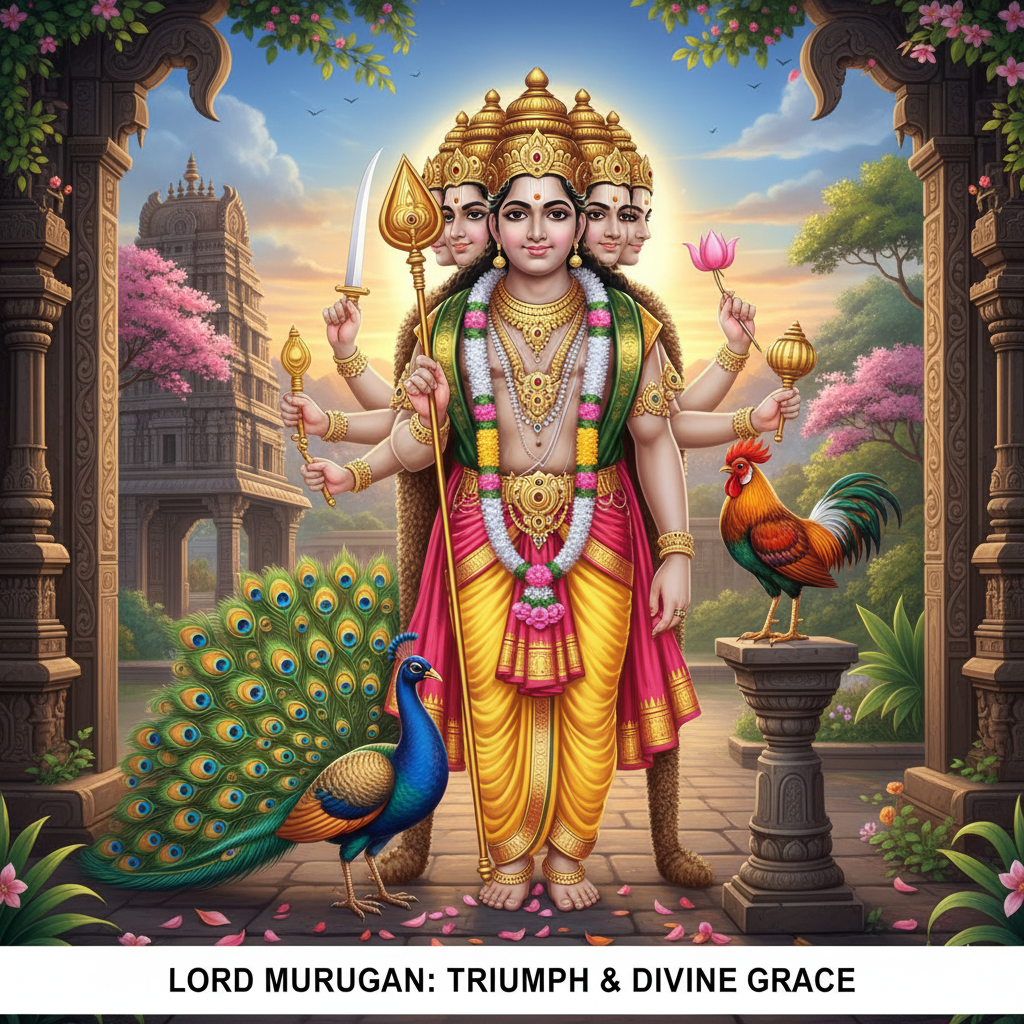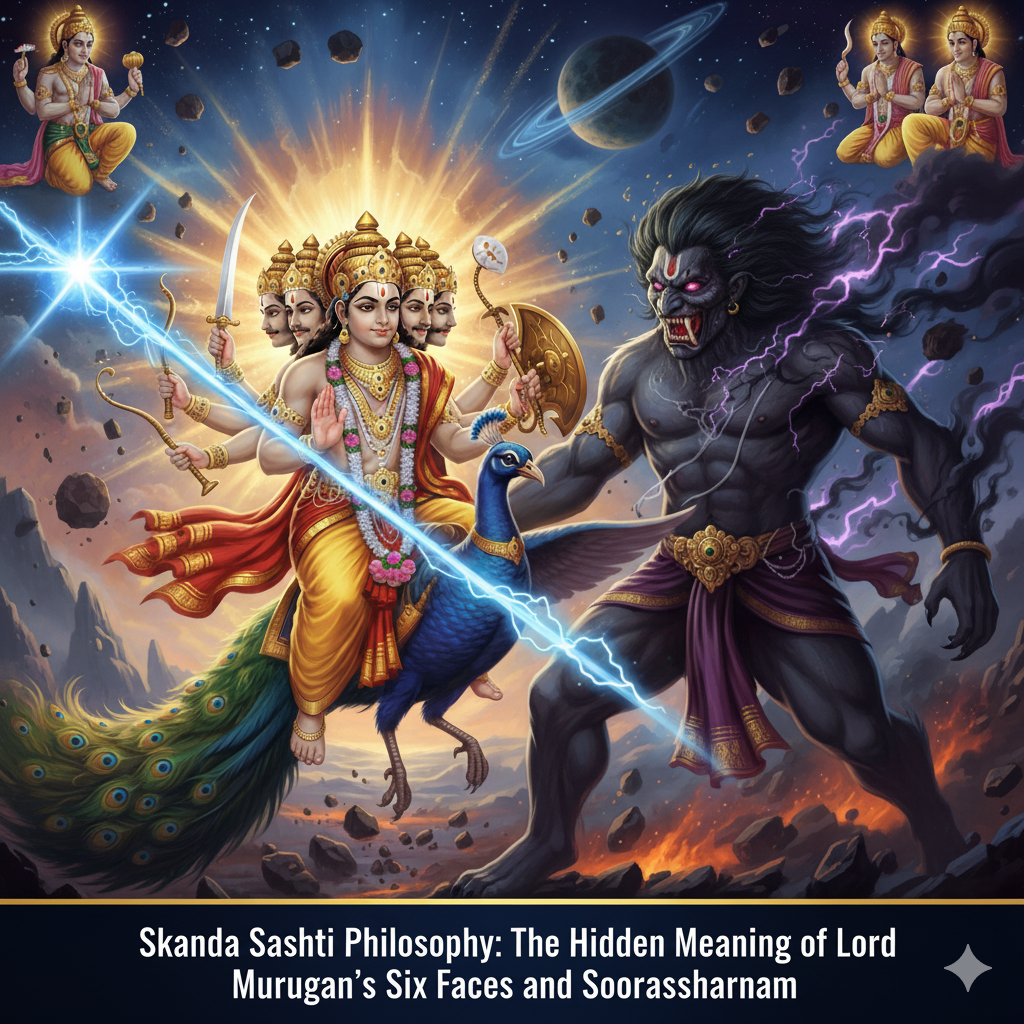Lord Murugan, also known as Skanda or Kartikeya, is a revered deity in Hinduism, particularly celebrated during Skanda Sashti and for the epic event of Soorasamharam. His iconography, especially the six faces and the dramatic Soorasamharam narrative, holds profound spiritual significance.

Legend has it that Goddess Parvati, Lord Murugan’s divine mother, once asked him, “My son, why did you manifest with six faces?”
Lord Murugan’s beautiful reply was: “Mother, if I were to appear to devotees with just one face, they would receive only the compassion emanating from that single face. But with six faces, they are blessed with the boundless compassion from all six!”
This profound message of universal love and grace is beautifully echoed in the verses of the renowned poet Kachiyappa Sivachariyar, from his epic ‘Kumara Sambavam,’ a hymn praising Lord Murugan:
“Praise to the six faces, praise to the grace flowing from them, Praise to the twelve shoulders worshipped by all, Praise to the lotus feet of the youthful Lord dwelling under the mango tree of Kanchi, Praise to the Rooster and the Peacock, praise to his divine Vel, praise!”
Let’s delve deeper into the spiritual truths embedded within these lines and the essence of Soorasamharam.
The Philosophy of Soorasamharam: Conquering the Three Impurities (Mummalangal)
Just as Lord Murugan’s six faces shower compassion, the origin of his rooster banner and peacock vehicle after Soorasamharam reveals a deep spiritual philosophy.
🐓 The Peacock and the Rooster Banner:
During his fierce battle with Surapadman, the asura employed various illusionary tactics to deceive Lord Murugan. As a last resort, Surapadman transformed into an unmoving mango tree, believing the young divine child would be outsmarted.
Lord Murugan, however, wielded his potent Shakti Vel (divine spear) and hurled it towards the tree. The Vel pierced the tree, splitting it into two. As the halves fell, one transformed into a rooster, and the other into a peacock.
In that ultimate moment, Surapadman’s ego (Ahankaram) and attachment (Mamkaram) were destroyed. Recognizing this purification, Lord Murugan adopted the peacock as his vehicle and the rooster as his banner.

🖤 The Three Impurities (Mummalangal): Surapadman’s Three Forms
Surapadman and his brothers represent the three types of impurities (Mummalangal) that reside within each of us.
- Tarakaasuran ➡️ Mayai (Illusion/Delusion): Upon birth in this world, we often believe, “I can conquer anything,” or “I can change the world.” This is Mayai, arising from our strength and wealth. Tarakaasuran’s destruction in Lord Murugan’s war signifies the removal of this illusion.
- Simhamukhan ➡️ Kanmam (Karma/Actions): Our past karma determines our human birth, our family, and the various outcomes we experience. Simhamukhan, though inherently good, fought for his brother due to his karmic ties. Simhamukhan’s defeat symbolizes the removal of karmic impurities. (Karma dissolves at the feet of the Divine.)
- Surapadman ➡️ Ahankaram (Ego/Arrogance): The ‘I’ consciousness, the sense of ‘I can do it,’ and Mamkaram (attachment) constitute Ahankaram. Only when Mayai and Kanmam are purified can this ego be overcome. Surapadman’s transformation into a mango tree, despite knowing Lord Murugan’s divine nature, was a manifestation of his ego. It was only when the Vel pierced him and he transformed into the rooster and peacock that his Ahankaram was completely annihilated.
Soorasamharam: Not Destruction, But Divine “Good Garland”
That is why the annihilation of Surapadman is not merely referred to as ‘Sooran Vathai’ (destruction of Suran), but as ‘Soorasamharam’.
- Samharam (समहारम्) is derived from Sanskrit: Sam+Haram
- Haram means Garland.
- Sam means Good or Beneficial.
- Thus, Samharam signifies a “Good Garland”.
The Divine weaves purified souls into a garland. When Surapadman’s ego and attachment were destroyed, he became a part of this divine garland (Samharam).
The act of transforming a wicked being, by removing his negative qualities and embracing him into the divine fold, exemplifies Lord Murugan’s unparalleled grace! This narrative of Soorasamharam teaches us that when our negativities are purged, the Divine embraces us.
To experience the profound grace of Lord Murugan and understand the deeper meanings of Skanda Sashti and Soorasamharam, let us constantly strive to overcome our inner ‘Surapadmans’ – our Mayai, Kanmam, and Ahankaram. May the divine Vel guide us to liberation and union with the Supreme. 🙏







